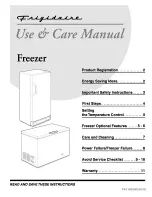
42
EN
SAVING ENERGY
• Do not place the refrigerator near
heat sources (electric heaters,
kitchen stove;
• Ensure air circulation around the
refrigerator; allow meals to cool to
room temperature before placing
them in the refrigerator;
• While the freezer compartment is
being defrosted, transfer all of the
products to the cooling compart-
ment, so that the temperature of the
frozen products helps maintain the
temperature of the products in the
cooling compartment;
• Defrost the refrigerator if a layer of
ice forms, as this thick layer of ice
impedes the cooling of the products
being frozen and increases power
consumption;
• When loading and unloading
products, follow the principle: "doors
opened for a while"; this will limit the
formation of frost on the walls of the
freezer compartment's evaporator;
• Adjust the temperature setting
according to the volume of the
p r o d u c t s p l a c e d i n t h e t w o -
compartment refrigerator.
To take the refrigerator out of operation
for a longer period:
• Switch it off and remove the plug
from the socket;
• Remove products from the cooling or
freezer compartments (as required);
• Wash and wipe dry the interior of the
cooling or freezer compartment;
wash all accessories' elements
(vegetable drawer, side shelves,
glass racks, rack frames);
• Leave the doors to all of the refriger-
ator's compartments open a crack to
prevent the formation of unpleasant
odours.
• Vacuum clean dust from the con-
denser and parts behind the refriger-
ator on a regular basis, 1 – 2 times a
year. Before using the vacuum
cleaner, switch off the product and
remove the plug from the socket.
When performing these steps, be
careful not to damage wiring,
junction boxes or the capillary tube.
















































